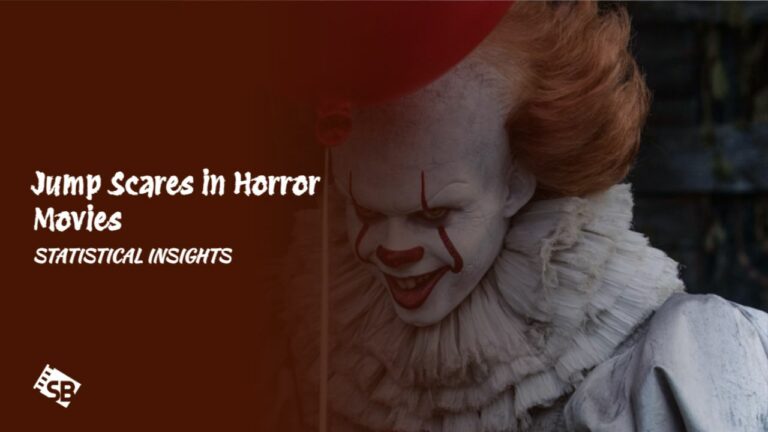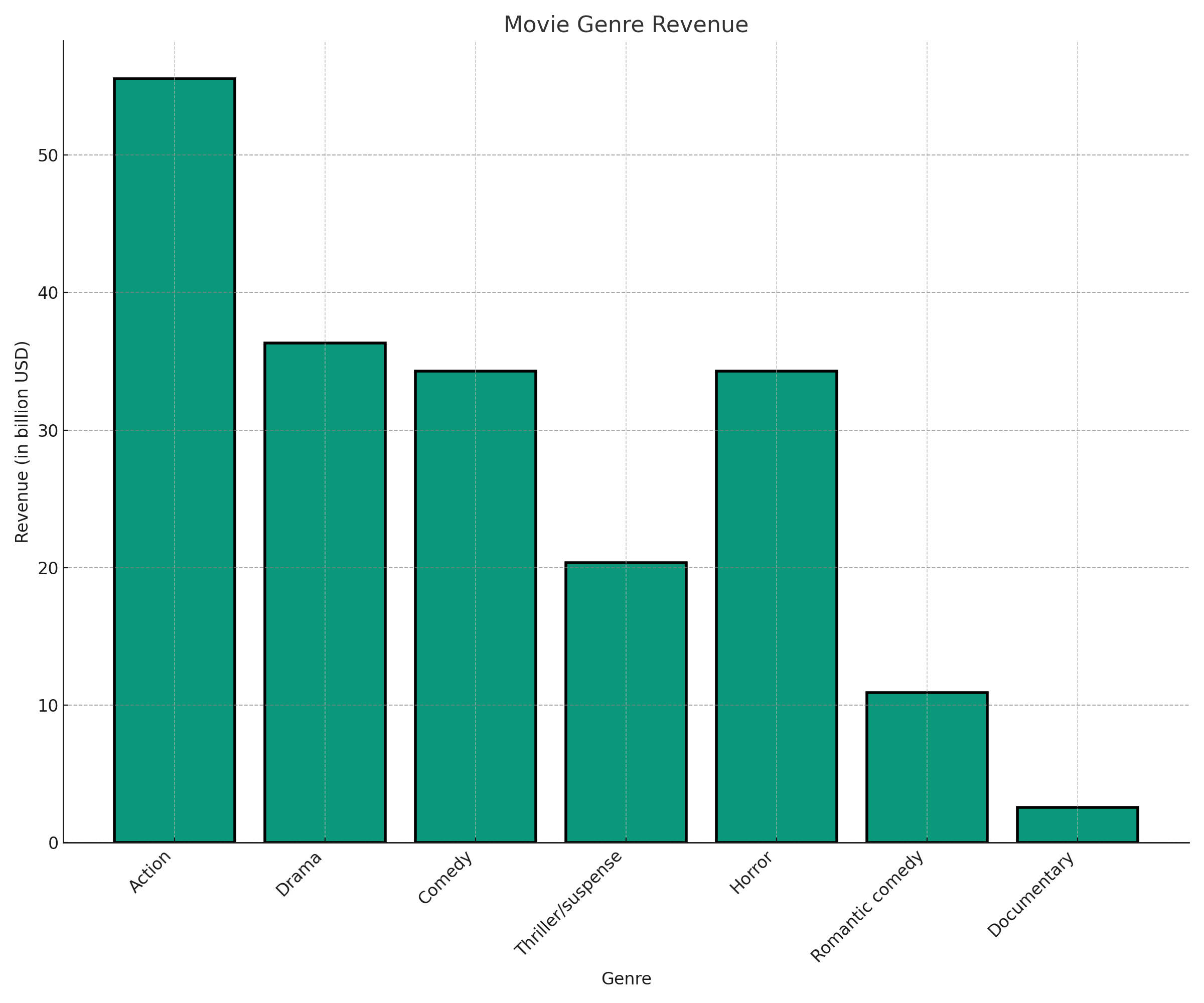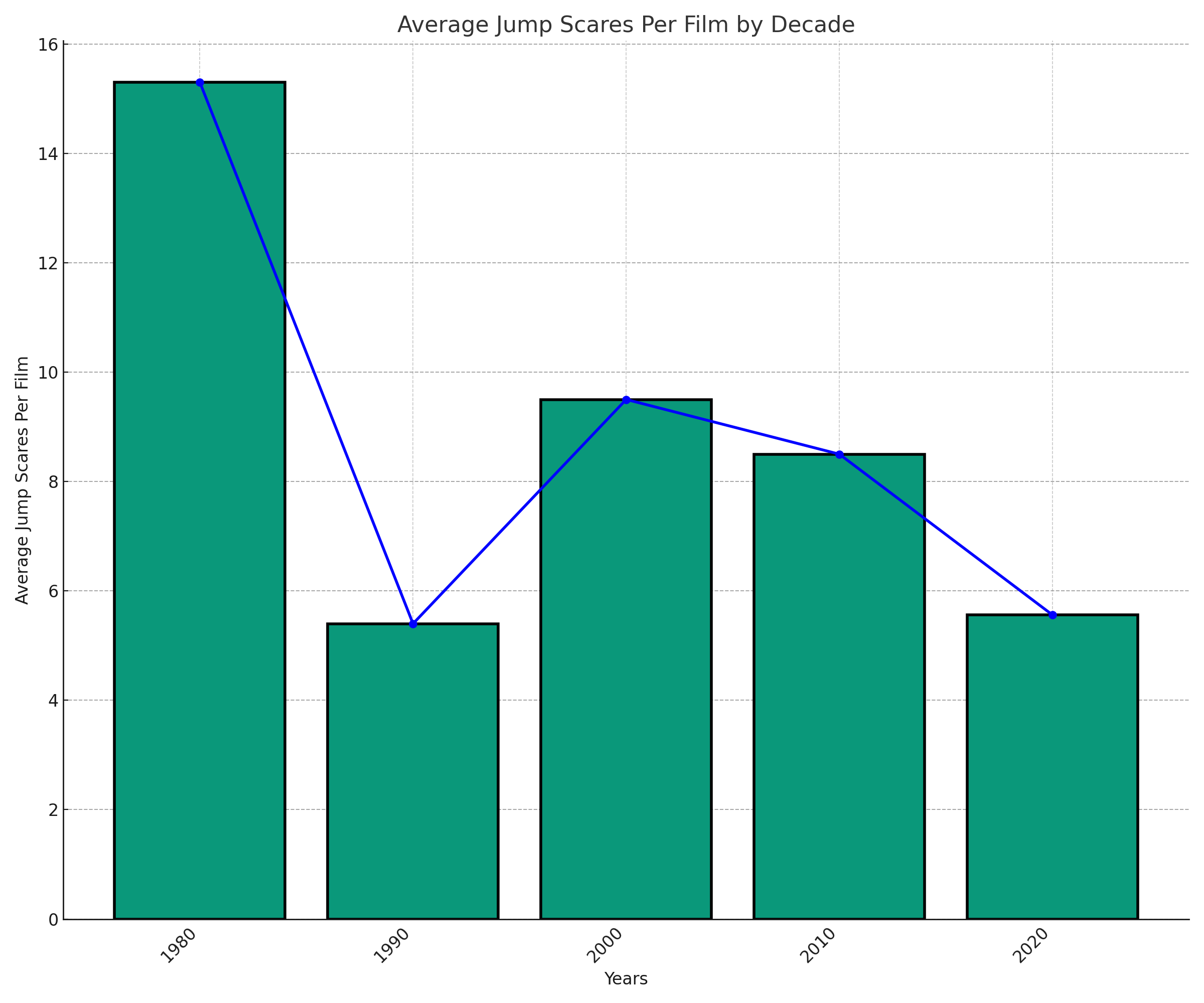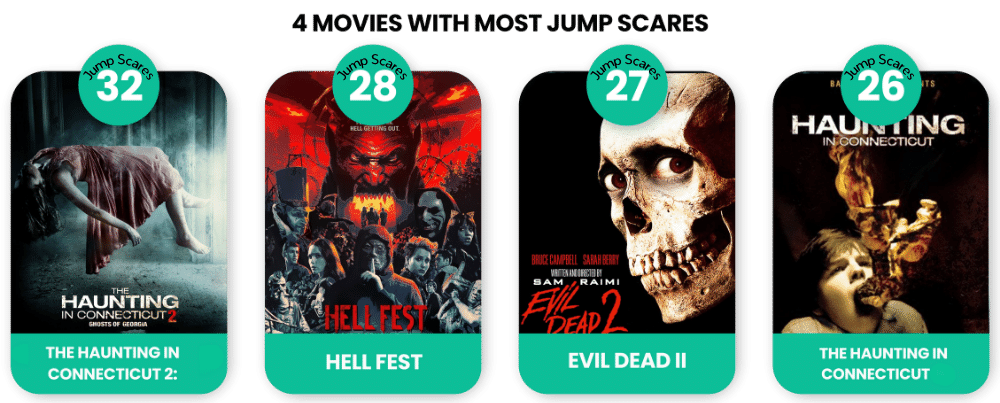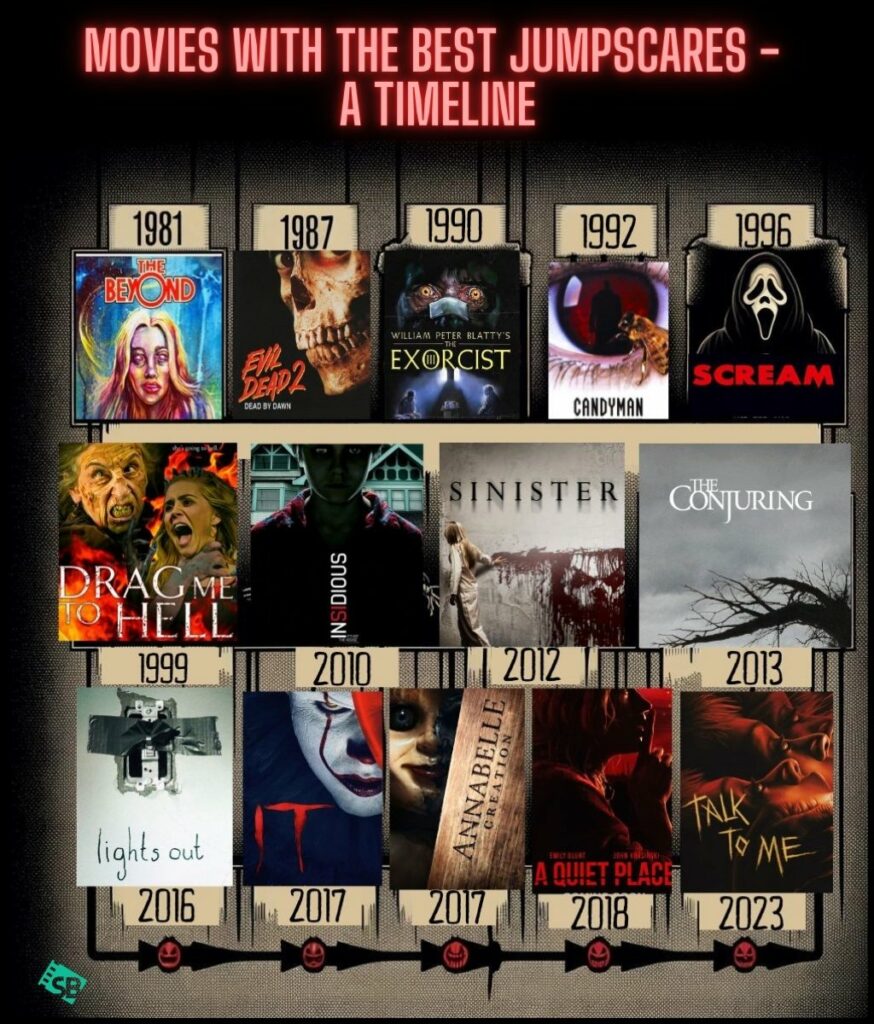We’ve all been there – reclining in the theater, popcorn clutched in hand when a sudden BANG! on the soundtrack sends you rocketing upright in your seat. The horror genre thrives on these jolting moments; the jump scares that leave us breathless and wanting more.
I am always on the quest for the next best scare. Recently, I watched the trailer of “Tarot,” which left me with a bad taste. In a particularly tense moment during the trailer, a monstrous face lunges at the tarot card reader. It wasn’t much of a scare.
I’ve often wondered what makes a jump scare truly effective. Is it all just a cacophony of loud noises and creepy crawlies, or is there something more to it?
I guess the quest continues…
For The Love of Scary Movies
Although movies are relatively new in the grand scheme of history, they serve as a reflection of our collective culture and consciousness.
This insightful infographic by Bo McCready (@BoKnowsData) offers an interactive exploration of film genre popularity over the past century. It’s intriguing to observe how different genres have evolved over time, with some gaining prominence and others waning.
Source: Boknowsdata
People love watching horror films. Cinemas often get sold out, making it a communal experience. But they’ve never been as popular as they are now.
From the 2000s onward, horror movies have stayed consistently popular. The genre keeps evolving with new themes and subgenres, attracting diverse audiences. Modern horror films, franchises, and the rise of horror streaming content have boosted this interest.
Overall, this genre has increased in popularity over the past century, especially since the 1980s. This is due to the genre’s ability to innovate and meet fans’ desire for thrilling and intense experiences.
Source: Statista
This is also proven by the substantial revenue of horror movies, matching comedy in total earnings. Between 1995 and 2022, horror ranked as the sixth most popular movie genre in the United States and Canada, generating over $13 billion in revenue during this period.
These movies have a strong appeal and enduring popularity. Plus, they offer a unique mix of fear and excitement, drawing audiences who seek thrilling and spine-chilling experiences.
But the fact that many people just sit there, waiting to be scared witless, goes against all common sense.
What’s Going on in the Heads of Horror Movie Fans?
A study at Johns Hopkins Carey Business School found that there has been a growing demand for experiences designed to evoke negative emotions. It could be because:
- Horror provides mental and physical stimulation.
- Exposure to terrifying acts can evoke both negative feelings (fear, anxiety) and positive feelings (excitement, joy).
- We often feel positive emotions when something makes us feel negative.
- Horror offers novel experiences, like zombie apocalypses, not found in the real world.
- It’s a safe way to explore the dark side of humanity.
People who enjoy horror movies are quite simple, really. They are open to new experiences and the resulting feelings without risking danger.
And science proves that it’s a good feeling. Good jump scares can get your heart racing to 140 beats per minute (good workout without moving a muscle), but the lower-quality ones make me question why I picked up the movie in the first place.
When the threat is real, horror fans might find themselves better equipped to handle stress. A survey of 322 people indicated that participants who enjoyed horror and pandemic-related fiction were more psychologically resilient and felt more prepared during the COVID-19 pandemic. Interesting!
How Horror Movie Jump Scares Became a Must-Have
Jump scares have always been highly sought after. Darryl Jones, a doctor of philosophy and professor of popular literature at Trinity College in Dublin, cites classical Greek tragedies, violence, mayhem, and gore as some of the earliest examples of people seeking this kind of thrill.
Before horror movies became popular, people were drawn to experiences such as Russian ice slides (early versions of modern roller coasters).
Then came the movies.
Before the 1980s, jump scares were relatively rare in horror movies. However, they quickly became common in the early ’80s as the slasher subgenre gained fans. Recently, jump scares in horror films have reached a new peak. An average movie contains at least six to ten jump scare scenes.
Source: The News House
The chart reveals how the use of jump scares in horror films has fluctuated, with the highest average in the 1980s and significant variations in subsequent decades.
I would like to note the 1976 film “Carrie” featured one of the first modern jump scares. The scene at the end left a lasting impression and inspired the use of a final jump scare in the 1980 movie “Friday the 13th“. It showed that even a dead villain can deliver one last shock, a trope that has since become common in horror films.
The evolution of horror movie jump scares from these early uses to a staple of horror cinema shows a deep understanding of audience psychology. Filmmakers recognized that a jump scare’s sudden, unexpected fright can powerfully engage viewers, making it a must-have element in horror movies.
Horror Movies with the Highest Count of Jump Scares
Classics like “The Exorcist” and modern hits like “The Conjuring” are renowned for their jump scares, making viewers flinch and scream. But these cult classics are nowhere near the top when we look for movies with the most jump scares.
These movies masterfully build suspense and then deliver a shock, often with a combination of sound effects, visuals, and timing. The high count of jump scares in these films contributes significantly to their appeal, ensuring a thrilling experience for horror enthusiasts.
If you want to be spooked beyond your wildest imagination, here is the list of movies with the highest count of jump scare moments:
| S.No | Movie | Number of Jump scares | Ratings |
| 1 | The Haunting in Connecticut 2: Ghosts of Georgia (2013) | 32 | |
| 2 | Hell Fest (2018) | 28 | |
| 3 | Evil Dead II (1987) | 27 | |
| 4 | The Messengers (2007) | 27 | |
| 5 | The Haunting in Connecticut (2009) | 26 | |
| 6 | The Woman in Black (2012) | 25 | |
| 7 | Insidious (2010) | 24 | |
| 8 | Drag Me to Hell (2009) | 23 | |
| 9 | It: Chapter One (2017) | 23 | |
| 10 | Host (2020) | 23 | |
| 11 | The Grudge (2004) | 23 | |
| 12 | It: Chapter Two (2019) | 23 | |
| 13 | Annabelle: Creation (2017) | 23 | |
| 14 | Scream 3 (2000) | 23 | |
| 15 | The Conjuring 2 (2016) | 22 | |
| 16 | Insidious: Chapter 2 (2013) | 22 | |
| 17 | Halloween Kills (2021) | 22 | |
| 18 | The Evil Dead (1981) | 22 | |
| 19 | Alone (2007) | 21 | |
| 20 | The Nun (2018) | 21 | |
| 21 | The Curse of La Llorona (2019) | 20 | |
| 22 | Evil Dead (2013) | 20 | |
| 23 | Annabelle Comes Home (2019) | 20 | |
| 24 | The Grudge (2020) | 19 | |
| 25 | The Conjuring: The Devil Made Me Do It (2021) | 18 | |
| 26 | The Amityville Horror (2005) | 18 | |
| 27 | Paranormal Activity (2007) | 17 | |
| 28 | Poltergeist (2015) | 16 | |
| 29 | The Ring (2002) | 16 | |
| 30 | The Ring Two (2005) | 15 |
Since 2014, Hollywood has significantly reduced the number of jump scares in its movies, as documented by Where’s The Jump. This impressive catalog features over 1,000 films and meticulously records the time stamps of startling moments, such as slamming doors and sudden attacks, that can make viewers jump.
The team at ScreenBinge discovered this valuable resource, and we’ve been making good use of it. We admire the dedicated effort put into tracking these jump scares, like those in the second “Haunting in Connecticut” film, which boasts the highest jump count on the site with 32 scares. For example, at 21:02, “The decomposing corpse appears directly in front of Lisa as she opens her eyes.”
The Nature of the Jump Scare
The classic horror movies of the 1960s and 1970s, like “Psycho” and “Suspiria,” used jump scares sparingly.
Some, like “Rosemary’s Baby,” didn’t have any jump scares at all. But the slasher films of the ’80s changed that, increasing the number of jump scares with killers like Freddy Krueger and Michael Myers terrorizing teenagers.
When these slasher movies were remade in the 2000s and 2010s, the jump scares increased too. Laura Mee, a film and television studies lecturer and author of “Reanimated: The Contemporary American Horror Remake,” explained that remakes often add jump scares to differentiate from the original and carve their own identity.
I wondered if the nature of jump scares had changed. Fortunately, Where’s The Jump lets contributors classify each jump scare as major or minor. While major jump scares have remained steady, minor jump scares have significantly declined since 2015.
However, defining “major” and “minor” is subjective since Where’s The Jump allows contributors to categorize them.

Minor jump scare: A shadow passes from behind, the door suddenly slams, or a cat jumps out at the protagonist. These scares focus on startling the viewer rather than advancing the plot.

Major jump scare: A monster suddenly lunges from the darkness, a creature is suddenly illuminated by a flickering light. These scares often reveal hidden characters and play a key role in the movie’s plot.
It turns out that there are several types of jump scares: startling sounds, sudden movements, unexpected attacks, and reveals of hidden characters. Minor jump scares often involved sounds, while major jumps usually included reveals and sudden movements. Major jump scares also tended to fall into multiple categories.
Despite this, descriptions of major and minor jump scares often looked similar, even in the same movie. For example, in the 1980’s “Friday the 13th,” Pamela grabbing Jack is a minor scare, while Jason grabbing Alice on the lake is a major scare. The difference is in the setup.
Horror Movie Jump Scares Scenes: Best & Worst Horror Picks From ScreenBinge
Let’s look at the jump scares gone wrong first, saving the good ones for later.
-
Horrible Horror – Watch At Your Own Risk!
These are some jump scares that have sparked horror in the audiences’ hearts for all the wrong reasons:
Sinister (2012)
In Sinister (2012), directed by Scott Derrickson, the film employs haunting 8mm footage and unsettling depictions of evil children to create a genuinely eerie atmosphere. However, its finale undermines this subtlety with a gratuitous jump scare.
As the film draws to a close, with the children revealed as the culprits in a cult-like worship of Bughuul, the audience expects a quietly creepy ending. Instead, Bughuul unexpectedly jumps from the frame’s side with a loud crash, employing a jarring shock tactic that feels unnecessary and diminishes the film’s crafted suspense.
Insidious: The Red Door (2023)
Insidious: The Red Door is the latest installment in James Wan’s Insidious universe. It belongs to the list of the best horror movies of all time. This film brings back Ty Simpkins and makes logical extensions from the first two films.
However, the film suffers from an over-reliance on jump scares, which seems almost mandated by a formulaic approach to the horror genre. This excessive use of jump scares disrupts the film’s dramatic core, which centers on Josh and Dalton Lambert, unraveling the mystery of their susceptibility to possession from entities in The Further.
The Nun (2018)
The Nun is set within the eerie expanse of The Conjuring universe and promises a horror narrative deeply rooted in its religious themes. However, the film largely fell short of these expectations, opting for a barrage of predictable and formulaic jump scares.
Critically panned yet commercially successful, The Nun serves as a stark illustration of how over-reliance on jump scares can undermine a horror film’s potential to explore more profound fears. The movie’s infamous advertising campaign, which featured an unskippable jump scare on YouTube, highlights its primary reliance on shock tactics over storytelling.
Unskippable jumpscare ad for “The Nun”
byu/Frank_Gomez_ inassholedesign
-
Best of the Best: Scares That Actually Made Me Jump
Interested in exploring the world of horror movies and TV but unsure where to begin? Here are a few recommendations to get you started.
It (2017)
It (2017), adapted from Stephen King’s renowned novel, masterfully incorporates one of the most memorable jump scares that shocks and significantly elevates the film’s horror quotient. In a particularly harrowing scene, Bill goes into a flooded basement, where he sees his lost younger brother, Georgie.
As Georgie hauntingly chants, “You’ll float too,” the tension builds palpably. The camera then chillingly reveals Pennywise the Clown lurking in the murky water, partially obscured.
Despite the audience’s anticipation of a scare, Pennywise’s sudden attack as he lunges at Bill delivers a visceral shock. Bill narrowly escapes, but the scene chills the audience to the bone.
The Ring 2 (2005)
In The Ring 2, the county fair jump scare still sends shivers down my spine. During this scene, Aidan finds himself alone in a restroom, taking photographs of his reflection in the mirror. With each snapshot, the reflection grows increasingly disturbing as Samara appears progressively closer to Aidan.
Thankfully, Aidan escapes unharmed as someone else enters the bathroom, interrupting Samara. Despite an anticlimax, this scene from The Ring franchise profoundly impacted me to the point where I still find myself avoiding the bathroom mirror at night.
Late Night with the Devil (2024)
One of the most talked-about jump scares from recent horror movies comes from the 2024 film Late Night with the Devil. In one jump scare, a malevolent entity suddenly confronts David Dastmalchian’s character during a live broadcast. This scene is particularly intense and has been widely praised for its unexpectedness.
The Critics Take On This Horrifying Phenomenon
Even though all jump scares do not fall into the horror film clichés category, there are multiple reasons why it’s a controversial phenomenon. Let’s have a look!
Critics argue that jump scares are a cheap tactic for quick thrills. It’s the easy way out for filmmakers who’d rather not spend on crafting a narrative that builds genuine suspense and atmosphere. The criticism stems from the belief that jump scares rely on the element of surprise rather than storytelling skills to elicit a reaction from the audience.
This can lead to a reliance on loud noises or sudden movements to startle viewers, which some argue is less skillful than creating a creeping sense of dread through mood, tension, and anticipation.
Furthermore, critics suggest that the overuse of horror movie jump scares can detract from the buildup of true suspense in a film. Instead of allowing the audience to immerse themselves in the story and characters, frequent jump scares can break the immersion and reduce the overall quality of the horror experience.
In essence, while jump scares can be effective when used sparingly and in conjunction with other horror techniques, some critics feel that their overuse can undermine the potential for a horror film to be truly terrifying in a more profound and lasting way.
Final Reflections
Jump scares are famous for creating instant reactions ranging from heart-pounding terror to eye-rolling annoyance. Over the years, they have evolved from simple shock tactics to complex, narrative-enhancing tools.
While some critics and fans see them as cheap tricks that undermine genuine suspense, others celebrate them as essential elements defining horror movies’ thrill. A horror movie’s effectiveness hinges largely on its execution and integration into the storyline.
As we continue to see evolution in horror filmmaking, jump scares will likely be refined further, potentially leading to new and innovative ways to scare us.
